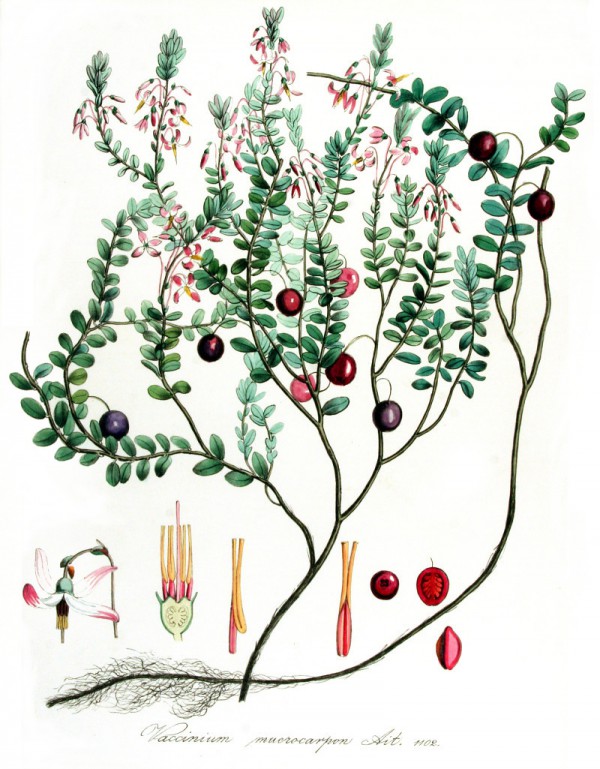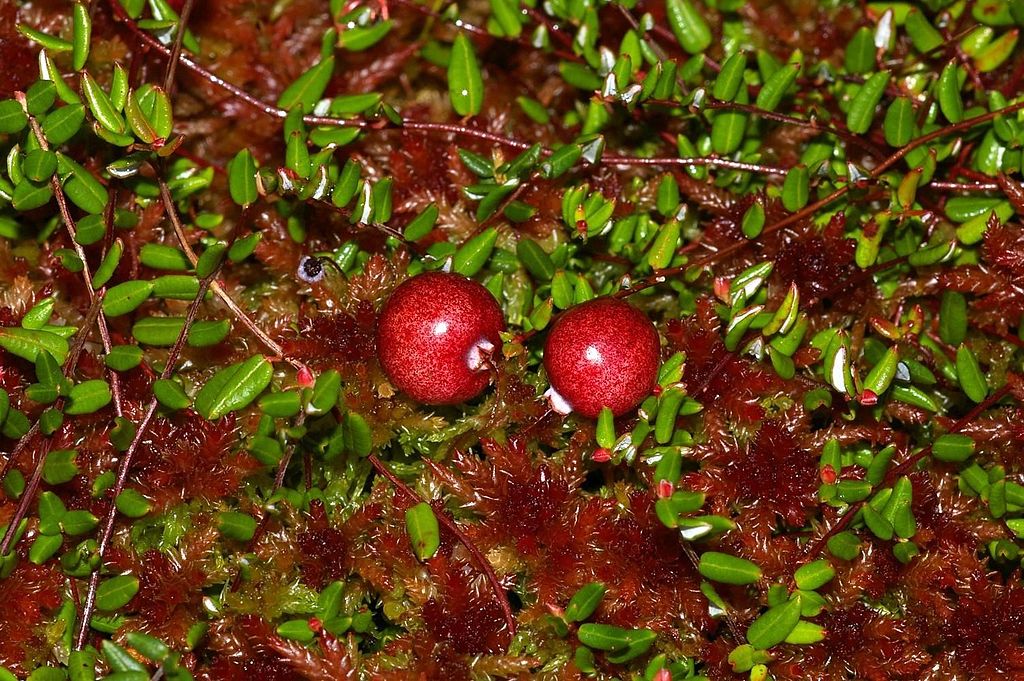Dies ist eine alte Version des Dokuments!
Vaccinium oxycoccos var. oblongifolium Michx. - syn.Vaccinium macrocarpon Ait.; Oxycoccus macrocarpus (Ait.) Pursh. - Ericaceae
American cranberry, large cranberry, (Amerikanische) Cranberry, Großfrüchtige Moosbeere, Kranbeere
Perennial subshrub, native to eastern North America, introduced and escaping elsewhere, cultivated for fruit; leaves glaucous abaxially, green adaxially, narrowly elliptic to elliptic, entire; inflorescences in axils of leaflike bracts at base of current year’s shoots; flowers white to pink; berries red to pink, 9-14mm diameter.
http://www.efloras.org/florataxon.aspx?flora_id=1&taxon_id=250065705
The volatiles of fresh American cranberries are dominated by α-terpineol (23.7%), compared with 0.7% in lingonberries. Benzyl alcohol amounts to 9% (lingonberries 40%) in the essentital oil of cranberries. „Of great importance is also that 2-methyl butyric acid is missing or present in very small amounts… If these three compounds are exepted the amount of the different chemical groups of aroma compounds are rather similar in cranberries and lingonberries.“
[The aroma of cranberries. II. Vaccinium macrocarpon Ait., Anjou, K., Von Sydow, E., Acta Chem. Scand, Vol.21(8), 1967, 2076-2082]
http://actachemscand.org/pdf/acta_vol_21_p2076-2082.pdf
„Volatiles from the juice of the American cranberry (Vaccinium macrocarpon Ait.) were investigated using gas chromatography, mass spectrometry and infrared spectrophotometry. Forty-two compounds comprising over 95% of the aroma complex were identified. These consist of 14 aromatic compounds, 7 terpenes, 9 aliphatic alcohols, 6 aliphatic aldehydes and 6 other compounds including the 2 acids, benzoic and 2-methylbutyric. The aromatic compounds (benzaldehyde, benzyl and benzoate esters) and the terpenes appear to be the major contributors to the aroma of cranberry juice. The remaining 5% of the aroma complex contains over 200 components. Although these compounds occur in very small concentrations, they appear to be important in the overall aroma.“
[Major volatile components of the juice of American cranberry., Croteau, R.J., Fagerson, I.S., Journal of Food Science, vol.33(4), 1968, 386-389]
Of the 35 odor-active compounds detected by applying AEDA on the liquid ectract of cranberry, highest FD factors showed terpinolene (piney, sweet), decanal (citrus, peel), benzoic acid (balsamic), heptan-3-one (strong fruity, green, fatty), octen-3-one (mushroom), and (2E)-nonenal (waxy, cucumber), and are considered most important odorants in cranberry fruit. The main contributors to the aroma of cranberry fruit are esters (ethyl acetate, methyl butyrate, ethyl butyrate, benzyl acetate, anisyl acetate), terpenes (p-cymene, terpinolene, alpha terpineol), aldehydes (hexanal, octanal, nonanal, 2E-nonenal), acids (acetic acid, butyric acid, 2-ethylhexanoic acid, nonanoic acid, cinnamic acid, palmitic acid), two lactones (gamma tridecalactone, delta tetradecalactone), one one sulfur-compund, and one sulfur-nitrogen compound (2-isopropylthiazole). Compounds with relatively low FD factors included linalool oxide (floral, woody), trans-anethole (herbaceous), phenylethanol (floral), and vanillin.
Hanoglu A., Pucarelli F. „Recent Highlights in Flavor Chemistry & Biology. 8th. Deutsche Forschungsanstalt für Lebensmittelchemie; Garching, Germany: 2007. Determination of key aroma-active compounds by GC-O Aroma Extract Dilution Analysis (AEDA) in cranberry and blueberry fruits“ Proceedings of the Wartburg Symposium on Flavor Chemistry and Biology, Eisenach, Germany. Vol. 27.
Of the quantified compounds found with odor activity values (OAVs > 1) in four cultivars of cranberries (Early Black, Howes, Searles, and McFarlin), hexanal (OAV 27-60), pentanal (OAV 31-51), (E)-2-heptenal (OAV 17-66), (E)-2-hexenal (OAV 18-63), (E)-2-octenal (OAV 10-28), (E)-2-nonenal (OAV 8-77), ethyl 2-methylbutyrate (OAV 10-33), β-ionone (OAV 8-73), 2-methylbutyric acid (OAV 18-37), and octanal (OAV 4-24) contributed most to the aroma of cranberry. The Searles cultivar was highly correlated with the sensory descriptors “floral” and “fruity”, and the McFarlin cultivar was greatly related to the sensory descriptors “mellow” and “green and grass”.
[Characterization of the Key Aroma Volatile Compounds in Cranberry (Vaccinium Macrocarpon Ait.) Using Gas Chromatography–Olfactometry (GC-O) and odor activity value (OAV)., Zhu, J., Chen, F., Wang, L., Niu, Y., Chen, H., Wang, H., Xiao, Z., Journal of agricultural and food chemistry, 64(24), 2016, 4990-4999]
„A total of 400 mg of total flavonoids and phenolic compounds/l of sample was found in a freshly squeezed cranberry juice, which was distributed as about 44% of phenolic acids and 56% of flavonoids. Benzoic acid was the major phenolic compound. Major flavonoids in the freshly squeezed cranberry juice were quercetin and myricetin.“
[Separation and determination of flavonoids and other phenolic compounds in cranberry juice by high-performance liquid chromatography., Chen, H., Zuo, Y., Deng, Y., Journal of Chromatography A, 913(1), 2001, 387-395]
„Ethyl acetate extracts of Sephadex LH20-purified proanthocyanidins of American cranberry (Vaccinium macrocarpon Ait.) exhibited potent biological activity by inhibiting adherence of uropathogenic isolates of P-fimbriated Escherichia coli bacteria to cellular surfaces containing α-Gal(1 → 4)β-Gal receptor sequences similar to those on epithelial cells in the urinary tract. The chemical structures of the proanthocyanidins were determined by NMR, electrospray mass spectrometry, matrix-assisted laser absorption time-of-flight mass spectrometry and by acid catalyzed degradation with phloroglucinol. The proanthocyanidin molecules consisted predominantly of epicatechin units with mainly DP of 4 and 5 containing at least one A-type linkage. The procyanidin A2 was the most common terminating unit occurring about four times as frequently as the epicatechin monomer.“
[The structure of cranberry proanthocyanidins which inhibit adherence of uropathogenic P-fimbriated Escherichia coli in vitro., Foo, L.Y., Lu, Y., Howell, A.B., Vorsa, N., Phytochemistry, Vol.54(2), 2000, 173-181]
„Cranberry juice is recommended for the prevention and treatment of urinary tract infections (including cystitis) and kidney disorders. It is rich in vitamin C and has been used against scurvy… Presently it is assumed that cranberry contains substances which prevent the adhesion of E.coli to bladder wall linings. If E.coli cannot adhere, there is no infection. Controlled clinical studies have demonstrated the efficacy of cranberry to treat bladder infections.“
[Medicinal Plants of the World. Ben-Erik Van Wyk and Michael Wink, Pretoria 2004, 334]
[Cranberry juice for the prevention of recurrences of urinary tract infections in children: a randomized placebo-controlled trial., Salo, J., Uhari, M., Helminen, M., Korppi, M., Nieminen, T., Pokka, T., Kontiokari, T., Clinical infectious diseases, Vol.54(3), 2012, 340-346]
http://cid.oxfordjournals.org/content/54/3/340.short

Vaccinium macrocarpon, Kops et al., J., Flora Batava, vol.14, t.1102 (1872)
http://plantgenera.org/species.php?id_species=1048392

Common Cranberry up close. Author: Christian Fischer CC BY-SA 3.0
Cranberry growing guide https://wildfoodshomegarden.com/Cranberry.html
